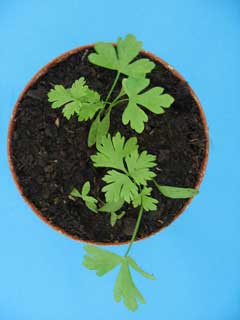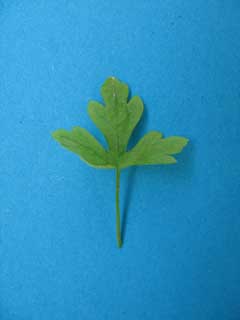 |
|
www.flickr.com/photos/andreasbalzer |
 |
| www.flickr.com/photos/andreasbalzer |
Translate this page:
Summary
Physical Characteristics

 Petroselinum crispum tuberosum is a BIENNIAL growing to 0.6 m (2ft) by 0.3 m (1ft in).
Petroselinum crispum tuberosum is a BIENNIAL growing to 0.6 m (2ft) by 0.3 m (1ft in).
See above for USDA hardiness. It is hardy to UK zone 7 and is not frost tender. It is in flower from June to August, and the seeds ripen from July to September. The species is hermaphrodite (has both male and female organs) and is pollinated by Insects. The plant is self-fertile.
It is noted for attracting wildlife.
Suitable for: light (sandy), medium (loamy) and heavy (clay) soils and prefers well-drained soil. Suitable pH: mildly acid, neutral and basic (mildly alkaline) soils. It can grow in semi-shade (light woodland) or no shade. It prefers moist soil.
UK Hardiness Map
US Hardiness Map
Synonyms
P. crispum radicosum. Baill.
Plant Habitats
Cultivated Beds;
Edible Uses
Edible Parts: Leaves Root
Edible Uses: Tea
Leaves - raw or cooked[33, 52]. Parsley is frequently used as a garnish or as a flavouring in salads and many cooked dishes, but has too strong a flavour to be eaten in quantity for most palates. The flavour of this form is inferior to the species[238]. The leaves are difficult to dry but are easily frozen[200]. Very rich in iron, parsley is also a good source of vitamins A, B and C[201]. Root - raw or cooked[16, 27, 33]. They can be grated into salads, baked or added to soups etc[183]. The root is harvested from autumn until new growth commences in the spring. It is hardy enough to be left in the ground during the winter, though can also be harvested in late autumn or early winter and stored in a cool, frost-free place, making sure that it does not dry out. Alternatively, the root can be cut into slices and then dried in a cool oven[244]. The root has a delicious flavour, intermediate between that of celery and parsley but with a nuttier flavour[37, 183]. A tea is made from the fresh or dried leaves, it is rich in vitamin C[21, 183]. An essential oil is obtained mainly from the leaves - used as a food flavouring[46].
References More on Edible Uses
Medicinal Uses
Plants For A Future can not take any responsibility for any adverse effects from the use of plants. Always seek advice from a professional before using a plant medicinally.
Antispasmodic Aperient Birthing aid Carminative Diuretic Emmenagogue Expectorant Galactogogue
Stomachic Tonic Vitamin C
Parsley is a commonly grown culinary and medicinal herb that is often used as a domestic medicine. Its prime use is as a diuretic where it is effective in ridding the body of stones and in treating jaundice, dropsy, cystitis etc[4, 238]. It should not be used by pregnant women, however, because it is used to stimulate menstrual flow and can therefore provoke a miscarriage[7, 238]. An infusion of the roots and seeds is taken after childbirth to promote lactation and help contract the uterus[238]. Parsley is also a mild laxative and is useful for treating anaemia and convalescents[244]. All parts of the plant can be used medicinally, they are antidandruff, antispasmodic, aperient, carminative, digestive, diuretic, emmenagogue, expectorant, galactofuge, kidney, stomachic and tonic[4, 7, 9, 21, 165, 201, 238]. Caution is advised on the internal use of this herb, especially in the form of the essential oil. Excessive doses can cause liver and kidney damage, nerve inflammation and gastro-intestinal haemorrhage[238]. It should not be prescribed for pregnant women or people with kidney diseases[238]. A poultice of the leaves has been applied externally to soothe bites and stings[4, 7], it is also said to be of value in treating tumours of a cancerous nature[4]. It has been used to treat eye infections, whilst a wad of cotton soaked in the juice will relieve toothache or earache[244]. It is also said to prevent hair loss and to make freckles disappear[244]. If the leaves are kept close to the breasts of a nursing mother for a few days, the milk flow will cease[7].
References More on Medicinal Uses
The Bookshop: Edible Plant Books
Our Latest books on Perennial Plants For Food Forests and Permaculture Gardens in paperback or digital formats.

Edible Tropical Plants
Food Forest Plants for Hotter Conditions: 250+ Plants For Tropical Food Forests & Permaculture Gardens.
More

Edible Temperate Plants
Plants for Your Food Forest: 500 Plants for Temperate Food Forests & Permaculture Gardens.
More

More Books
PFAF have eight books available in paperback and digital formats. Browse the shop for more information.
Shop Now
Other Uses
References More on Other Uses
Cultivation details
Prefers a moist well-drained soil in sun or partial shade[4, 16, 31, 37, 52, 200]. Prefers a good light soil that is not too light or acid[1], growing poorly in light acid soils[200]. A form of P. crispum (parsley) grown mainly for its enlarged edible root, the leaves can be used in all the ways that parsley is used and they are said to be hardier than parsley. Superficially similar to several poisonous species[7]. A good bee plant[18, 20]. A good companion plant, especially for growing near roses, tomatoes, carrots, chives and asparagus[18, 20, 54, 201], giving them all added vigour and protection against certain pests, especially carrot root fly and rose beetles[201].
References Carbon Farming Information and Carbon Sequestration Information
Temperature Converter
Type a value in the Celsius field to convert the value to Fahrenheit:
Fahrenheit:
The PFAF Bookshop
Plants For A Future have a number of books available in paperback and digital form. Book titles include Edible Plants, Edible Perennials, Edible Trees,Edible Shrubs, Woodland Gardening, and Temperate Food Forest Plants. Our new book is Food Forest Plants For Hotter Conditions (Tropical and Sub-Tropical).
Shop Now
Plant Propagation
Seed - sow late winter to early spring in situ. Germination can be slow, it helps to mark the rows by mixing a few radish seeds with the parsley seed[33]. Germination time can be reduced by pre-soaking the seed for 12 hours in hot water that is allowed to cool quickly, but be careful not to overdo the heat and cook the seed.
Other Names
If available other names are mentioned here
Native Range
Coming Soon
Weed Potential
Right plant wrong place. We are currently updating this section.
Please note that a plant may be invasive in one area but may not in your area so it's worth checking.
Conservation Status
IUCN Red List of Threatened Plants Status :

Growth: S = slow M = medium F = fast. Soil: L = light (sandy) M = medium H = heavy (clay). pH: A = acid N = neutral B = basic (alkaline). Shade: F = full shade S = semi-shade N = no shade. Moisture: D = dry M = Moist We = wet Wa = water.
Now available:
Food Forest Plants for Mediterranean Conditions
350+ Perennial Plants For Mediterranean and Drier Food Forests and Permaculture Gardens.
[Paperback and eBook]
This is the third in Plants For A Future's series of plant guides for food forests tailored to
specific climate zones. Following volumes on temperate and tropical ecosystems, this book focuses
on species suited to Mediterranean conditions—regions with hot, dry summers and cool, wet winters,
often facing the added challenge of climate change.
Read More
Expert comment
Author
(Bernh.)Crov.
Botanical References
200
Links / References
For a list of references used on this page please go here
Readers comment
© 2010, Plants For A Future. Plants For A Future is a charitable company limited by guarantee, registered in England and Wales. Charity No. 1057719, Company No. 3204567.